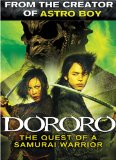| Reviews & Columns |
|
Reviews DVD TV on DVD Blu-ray 4K UHD International DVDs In Theaters Reviews by Studio Video Games Features Collector Series DVDs Easter Egg Database Interviews DVD Talk Radio Feature Articles Columns Anime Talk DVD Savant Horror DVDs The M.O.D. Squad Art House HD Talk Silent DVD
|
DVD Talk Forum |
|
|
| Resources |
|
DVD Price Search Customer Service #'s RCE Info Links |
|
Columns
|
|
|
Dororo
Universal // Unrated // September 23, 2008
List Price: $27.98 [Buy now and save at Amazon]
I have issues with invincibility. If a character is unable to be harmed by normal means, disconnection occurs almost instantly. Within the first couple of scenes in Dororo, a Japanese live-action anime adaption, you see a slimy spear-like tentacle jet out from from an arachnid-demon hybrid and shoot straight through lead character Hyakkimaru's torso and throat. Then, as to be expected, he stands up and brushes off the entry wound -- now fused back together at the slice -- as nothing more than a scratch. That kind of stuff can be frustrating, especially when it calls on you to place some kind of investment into the struggle of a character almost guaranteed to survive until the end. But Dororo works with this idea that Hyakkimaru isn't able to be killed, finding ways to dance around this concept for most of the acid-washed, weirdly competent slice of Japanese fantasy.
The Film:
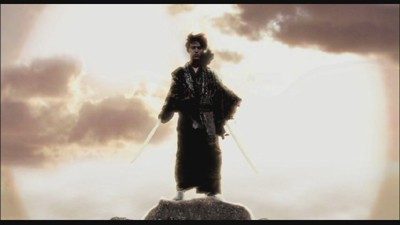
Dororo, which means something close to "little monster", spawns from the same mind, Osamu Tezuka, that brought about Astro Boy, the manga featuring a goofy shirtless little boy with slicked-back hair and rockets for shoes. This more grounded, non science-fiction based story arch first started as an intriguing manga series in the late '60s, branching out into a splendidly-animated television show that can be a little difficult to track down for American audiences. It features the demon (or goblin) hunting Hyakkimaru, a samurai in search of the 48 body parts divided and distributed to these ghastly creatures at his birth. In a deal with the devil, his father surrendered the life of the young boy in exchange for limitless power. This offer rendered the boy with nothing more than a featureless cranium and a blank canvas of a torso -- which was discovered in an abandoned state floating down a river inside a basket.
Through his discoverer's questionable healing powers as a mystic, Hyakkimaru gets built back together from the abandoned remains of children from a nearby village. Infused with Frankenstein-like electro-technology, the rest of his body is reanimated -- save his arms, which are replaced with blades used to for defense and wreaking vengeance. Sure, it's kind of a silly idea, but it's hard not to feel a little bit of bass-assness for a guy with katanas for arms, one of which is a singular blade made especially for killing demons. Ah, but it get's even more interesting; each time he kills one of his enemies, one part of his body becomes human as that very part falls off or out of his body violently. He brings a new meaning to the term "coughing up a lung".
Somehow this process meshed with a form of netherworld power to make his body indestructible, rendering him the ability to remove and attach his arms over the swords at will, heal his wounds with searing properties ... basically anything that makes his body invincible. That's a little hard to swallow and deterrent to the real "thirst" behind his ploy for vengeance and regained humanity, yet the acting talent that Japanese actor and bassist Tsumabuki Satoshi crafts for the emotional character keeps up a fine level of empathy for his desire to be wholly human again. It's interesting; if you've ever played the Neo-Geo video game Samurai Showdown, you'll notice lots of visual similarities between Hyakkimaru and the samurai Haohmaru. You might think that it would be a rip from that character, yet when you look back at the '60s Dororo form of Hyakkimaru, clearly twenty years Samurai Showdown's senior, he looks even more like the game's character.
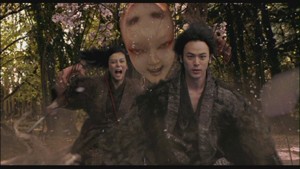
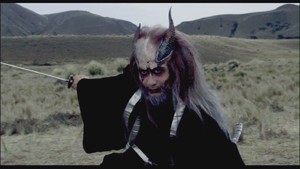
Hyakkimaru's boiling to the rim with interesting attributes, enough to fuel Dororo through a barrage of goblin and ghoul battles photographed in Power Rangers-style of combat. Early on, the cinematography leading up to the battle sequences takes on a peculiar personality by screaming at the camera with acidic greens and pinks. A bit of that eye-fluttering vision adjustment occurs that makes you a bit concerned that the display device might be sputtering out of control, almost like it's a Japanese samurai film seen through the eyes of a baked-out moviegoer. Shortly after, the visual design becomes more focused and rich, although it never loses much of its heavily contrasted / saturated visual style. Dororo, in spite of this, shows off a lot of substantial photography against rich landscapes, many of them natural earthen backdrops. Then, the unrelenting CG elements wedge in the film, which aren't all that smooth. In still-frame mode they look great, but when they're put in motion they look too "animated" to integrate into the image. Still, all this crafts a visual style that accentuates Hyakkimaru's somewhat mystical aura, making the crazy battle scenes where he leaps high into the air and swipes his blade down, followed by a typical anime-style pose afterwards, an entertaining enough experience.
His sidekick, however, leaves a bit to be desired. Named "Dororo" early in the story when he / she barraged our hero with annoying chatter, his gender-confused thief assistant mixes oddly with his emotive persona. Dororo (Shibasaki Kou, Battle Royale), though clearly a boy in the original manga, now embodies a sort of Freudian block on her feminine properties due in large part to her mother telling her to, well, act like a man until she meets someone as strong as her murdered father. She's out for revenge and bloodthirst as well for Hyakkimaru's father, which adds a form of odd testosterone / estrogen hybrid behind Hyakkimaru's efforts. But, I swear, if she were to rap that little drum of herswhile yelling loud song-like anecdotes directly at the screen one more time, I think I might've screamed. But each character's way of carrying themselves, their demeanors, and their interaction with the off-kilter CG elements makes Dororo a charming fantasy-style experience. It reminds me a bit of Takashi Miike's Great Yokai War, especially in tone -- one that seems too childish for older audiences, yet shows enough violence and macabre properties to be unsuitable for younger ones. Though it's immature and odd in the same breadth and edited much too long at nearly two-and-a-quarter hours, I still found myself entertained by the fantasticalness behind it all. Dororo is clearly the beginning of a two-part series that reflects on Hyakkimaru's ancestry and the ways it'll intermingle with his struggle to get all fourty-eight of his bodyparts back. Though the film's visual mood grates on the eyes a bit and balances oddly with its dramatic efforts, the director's style and Tsumabuki Satoshi's embodiment of Hyakkimaru would make me interested in seeing another installment.
The DVD:
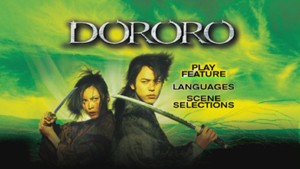

Universal brings us Dororo in a standard keepcase presentation with very loud green coverart and, as a deviant of sorts from their normal straight-silver aesthetic, a bright lime-green disc label.
The Video:
Dororo provides one of the more difficult transfers to judge, especially considering the fact that I haven't seen it theatrically. By default, I'm going to assume that the colors are accurate in this 1.85:1 image, enhanced for widescreen displays. Several scenes show off a lot of harsh saturation and contrast boosting, which renders a dark image at many, many points throughout. However, there are also a few "normal" scenes where the photography is given the chance to just breathe with a somewhat natural, somewhat oddly color-timed subdued palette. Edge enhancement is noticeable in a few spots, rendering a light halo effect around items like clothing in darker areas and against the CG creatures' faces. Yet, when asked to be heavily detailed in areas with intricate make-up effects and focused nuanced cinematography, Dororo handles itself quite well.
The Audio:
For an action film, I'd expect a little more oomph behind Dororo's Japanese 5.1 audio track. Surround channels are utilized in spots while the verbal and sound effects clarity sound great, but there's a significant lack of rumble within many of the louder scenes. It's a bit hollow down in the lower regions, as exhibited by the crash of the arachnid's tentacles and during the demon fighting montage at the core of the film. The treatment gets the job done, but it didn't provide the kind of activity that would make it an engaging audio experience. Though I can't compare, there's a Japanese Region 2 release with a DTS track that might sport a little more activity. If you don't want to bother with region coding, you'll still have a fine time with this commonplace mix. Only optional English and SDH subtitle tracks are available, which both handle the language well enough.
The Extras:
It also might be worth importing the first pressing of the Region 2 DVD for the supplemental features (Making-Of, Commentary, Deleted Scenes, etc) as there are no supplements included with this disc outside of a Scene Selection.
-----
Final Thoughts:
Fun, odd, and disposably entertaining, Dororo packs enough action and visual eye candy within its crazy little package to keep both anime and fantasy fans watching. It needs some trimming in the editing room and some polish with the smoothness of its visuals, but this adaptation of Osama Tezuka's manga is plenty fun to watch. Give it a Rental for its visual novelty and for the strong embodiment of a hero figure in Hyakkimaru, and if it's something that you like I'd probably look elsewhere for an import disc since this one's a barebones release.
Thomas Spurlin, Staff Reviewer -- DVDTalk Reviews | Personal Blog/Site
The Film:

Dororo, which means something close to "little monster", spawns from the same mind, Osamu Tezuka, that brought about Astro Boy, the manga featuring a goofy shirtless little boy with slicked-back hair and rockets for shoes. This more grounded, non science-fiction based story arch first started as an intriguing manga series in the late '60s, branching out into a splendidly-animated television show that can be a little difficult to track down for American audiences. It features the demon (or goblin) hunting Hyakkimaru, a samurai in search of the 48 body parts divided and distributed to these ghastly creatures at his birth. In a deal with the devil, his father surrendered the life of the young boy in exchange for limitless power. This offer rendered the boy with nothing more than a featureless cranium and a blank canvas of a torso -- which was discovered in an abandoned state floating down a river inside a basket.
Through his discoverer's questionable healing powers as a mystic, Hyakkimaru gets built back together from the abandoned remains of children from a nearby village. Infused with Frankenstein-like electro-technology, the rest of his body is reanimated -- save his arms, which are replaced with blades used to for defense and wreaking vengeance. Sure, it's kind of a silly idea, but it's hard not to feel a little bit of bass-assness for a guy with katanas for arms, one of which is a singular blade made especially for killing demons. Ah, but it get's even more interesting; each time he kills one of his enemies, one part of his body becomes human as that very part falls off or out of his body violently. He brings a new meaning to the term "coughing up a lung".
Somehow this process meshed with a form of netherworld power to make his body indestructible, rendering him the ability to remove and attach his arms over the swords at will, heal his wounds with searing properties ... basically anything that makes his body invincible. That's a little hard to swallow and deterrent to the real "thirst" behind his ploy for vengeance and regained humanity, yet the acting talent that Japanese actor and bassist Tsumabuki Satoshi crafts for the emotional character keeps up a fine level of empathy for his desire to be wholly human again. It's interesting; if you've ever played the Neo-Geo video game Samurai Showdown, you'll notice lots of visual similarities between Hyakkimaru and the samurai Haohmaru. You might think that it would be a rip from that character, yet when you look back at the '60s Dororo form of Hyakkimaru, clearly twenty years Samurai Showdown's senior, he looks even more like the game's character.


Hyakkimaru's boiling to the rim with interesting attributes, enough to fuel Dororo through a barrage of goblin and ghoul battles photographed in Power Rangers-style of combat. Early on, the cinematography leading up to the battle sequences takes on a peculiar personality by screaming at the camera with acidic greens and pinks. A bit of that eye-fluttering vision adjustment occurs that makes you a bit concerned that the display device might be sputtering out of control, almost like it's a Japanese samurai film seen through the eyes of a baked-out moviegoer. Shortly after, the visual design becomes more focused and rich, although it never loses much of its heavily contrasted / saturated visual style. Dororo, in spite of this, shows off a lot of substantial photography against rich landscapes, many of them natural earthen backdrops. Then, the unrelenting CG elements wedge in the film, which aren't all that smooth. In still-frame mode they look great, but when they're put in motion they look too "animated" to integrate into the image. Still, all this crafts a visual style that accentuates Hyakkimaru's somewhat mystical aura, making the crazy battle scenes where he leaps high into the air and swipes his blade down, followed by a typical anime-style pose afterwards, an entertaining enough experience.
His sidekick, however, leaves a bit to be desired. Named "Dororo" early in the story when he / she barraged our hero with annoying chatter, his gender-confused thief assistant mixes oddly with his emotive persona. Dororo (Shibasaki Kou, Battle Royale), though clearly a boy in the original manga, now embodies a sort of Freudian block on her feminine properties due in large part to her mother telling her to, well, act like a man until she meets someone as strong as her murdered father. She's out for revenge and bloodthirst as well for Hyakkimaru's father, which adds a form of odd testosterone / estrogen hybrid behind Hyakkimaru's efforts. But, I swear, if she were to rap that little drum of herswhile yelling loud song-like anecdotes directly at the screen one more time, I think I might've screamed.
The DVD:


Universal brings us Dororo in a standard keepcase presentation with very loud green coverart and, as a deviant of sorts from their normal straight-silver aesthetic, a bright lime-green disc label.
The Video:
Dororo provides one of the more difficult transfers to judge, especially considering the fact that I haven't seen it theatrically. By default, I'm going to assume that the colors are accurate in this 1.85:1 image, enhanced for widescreen displays. Several scenes show off a lot of harsh saturation and contrast boosting, which renders a dark image at many, many points throughout. However, there are also a few "normal" scenes where the photography is given the chance to just breathe with a somewhat natural, somewhat oddly color-timed subdued palette. Edge enhancement is noticeable in a few spots, rendering a light halo effect around items like clothing in darker areas and against the CG creatures' faces. Yet, when asked to be heavily detailed in areas with intricate make-up effects and focused nuanced cinematography, Dororo handles itself quite well.
The Audio:
For an action film, I'd expect a little more oomph behind Dororo's Japanese 5.1 audio track. Surround channels are utilized in spots while the verbal and sound effects clarity sound great, but there's a significant lack of rumble within many of the louder scenes. It's a bit hollow down in the lower regions, as exhibited by the crash of the arachnid's tentacles and during the demon fighting montage at the core of the film. The treatment gets the job done, but it didn't provide the kind of activity that would make it an engaging audio experience. Though I can't compare, there's a Japanese Region 2 release with a DTS track that might sport a little more activity. If you don't want to bother with region coding, you'll still have a fine time with this commonplace mix. Only optional English and SDH subtitle tracks are available, which both handle the language well enough.
The Extras:
It also might be worth importing the first pressing of the Region 2 DVD for the supplemental features (Making-Of, Commentary, Deleted Scenes, etc) as there are no supplements included with this disc outside of a Scene Selection.
-----
Final Thoughts:
Fun, odd, and disposably entertaining, Dororo packs enough action and visual eye candy within its crazy little package to keep both anime and fantasy fans watching. It needs some trimming in the editing room and some polish with the smoothness of its visuals, but this adaptation of Osama Tezuka's manga is plenty fun to watch. Give it a Rental for its visual novelty and for the strong embodiment of a hero figure in Hyakkimaru, and if it's something that you like I'd probably look elsewhere for an import disc since this one's a barebones release.
|
| Popular Reviews |
| Sponsored Links |
|
|
| Sponsored Links |
|
|
| Release List | Reviews | Shop | Newsletter | Forum | DVD Giveaways | Blu-Ray | Advertise |
|
Copyright 2024 DVDTalk.com All Rights Reserved. Legal Info, Privacy Policy, Terms of Use,
Manage Preferences,
Your Privacy Choices | |||||||









